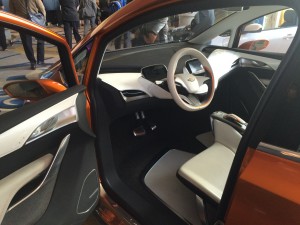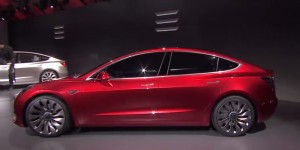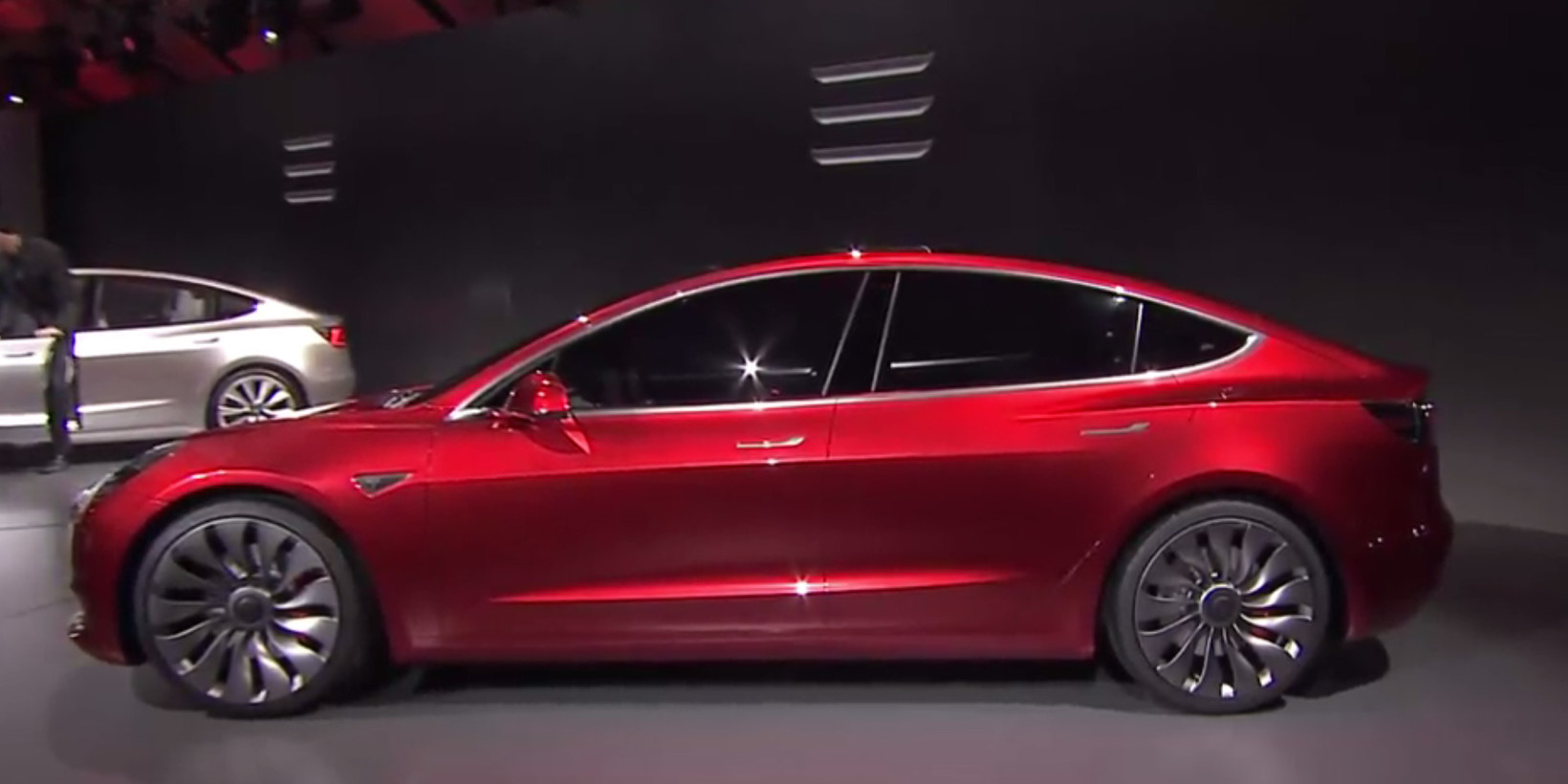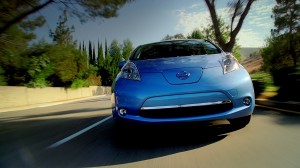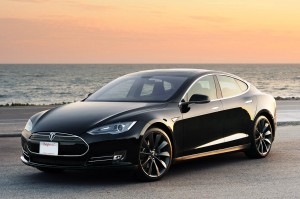Sure, electric vehicles are fun to drive, reduce local air pollution and greenhouse gas emissions, and can save you a lot of money on fuel at the same time. But are they safe?
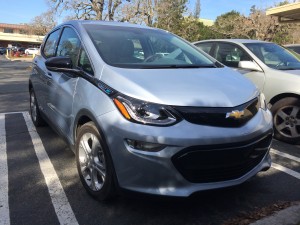 We know the Tesla Model S achieved the highest safety rating ever recorded by the federal government, mostly because of the lack of front engine block. As a result, the car has a huge crumple zone for cushion in the result of a front-end impact.
We know the Tesla Model S achieved the highest safety rating ever recorded by the federal government, mostly because of the lack of front engine block. As a result, the car has a huge crumple zone for cushion in the result of a front-end impact.
But what about the non-premium electric vehicles, particularly the new long-range, mass-market Chevy Bolt EV? The federal government has not released crash test information yet on this car, but a new safety test looks very promising, per cars.com:
Chevrolet’s all-electric car is the first of its kind to earn high safety scores from the Insurance Institute for Highway Safety. The safety group gave the 2017 Chevrolet Bolt EV the Top Safety Pick nod, one test short of its highest rating.
The electric hatchback earned good ratings in all five crash tests, including small overlap front, moderate overlap front, side, roof strength and head restraint evaluations; the Bolt’s optional front crash prevention system earned a superior rating. According to IIHS, the Bolt automatically avoided a crash in tests at both 12 and 25 mph.
Evidently the only knock on the car is the glare from its headlights. Meanwhile, the Nissan LEAF did not fare as well.
Like any car, design is important for safety. But the fact that EVs don’t have big engine blocks in front clearly gives them a strong advantage in this respect. It’s yet one more reason for consumers to consider making the switch from gas to electricity to power their vehicles.
Tesla driver Alex Venz got a 24-hour test drive of the new Chevy Bolt EV, as I did, and put together an extended video review. You could read an article write-up or see the video above. He gets into much more detail on all the various features and offers some helpful comparisons to the Tesla Model S (including his own 0-60 mph acceleration tests).
Meanwhile, initial sales figures for the Bolt are looking good, in just its first full month on sale in January. Green Car Reports describes the numbers:
When GM released its sales results this morning, the number turned out to be 1,162 deliveries. That brings total Bolt EV sales in roughly six weeks to 1,741—far ahead of both the Chevrolet Volt and Nissan Leaf after their first two months exactly six years ago.
The Volt plug-in hybrid, meanwhile, logged its own January sales of 1,611, against 996 in January 2016.
Including a few remaining Spark EVs, that means GM sold about 2,800 cars with plugs last month.
This is definitely a car to watch going forward.
The Chevy Bolt is a big deal. It’s the first sub-$30k (with incentives) electric vehicle that has an over-200 mile range. 238 mile rated range, to be precise, which seems to be holding up in real-world conditions. It’s set to hit the showrooms in January, and it should open up EVs to a much broader market of consumers.
In a very good sign, Motor Trend has already named it the 2017 Car of the Year:
Perhaps the most impressive thing about the Bolt EV is there are no caveats, no “for an electric car” qualifiers needed in any discussion. It is, simply, a world-class small car, and that’s before you factor in the benefits inherent in the smoothness, silence, and instant-on torque provided by the electric motor. The ride is firm and sporty, but transmitted road noise is very well damped. The steering has slightly artificial weighting, but brake feel is natural, and once you learn to use the higher regenerative braking modes, you can pretty much drive all the time without touching the friction brakes at all.
But some question the lack of sleek “coolness” that distinguishes Tesla from all the boxy or buggy EV competitors. In an otherwise positive review, Lawrence Ulrich at The Drive laments the aesthetics:
I truly hope I’m wrong here. But the Bolt, like so many would-be Detroit pioneers before it, fails to absorb the blackboard lesson of that hot professor Tesla: A cutting-edge car should be cool. It should spark daytime reveries and nighttime desire.
The Bolt’s cool factor, frankly, hovers right around zero. Electric tech aside, there’s no sense of gotta-have, from the kitchen-appliance exterior to a cheapskate cabin that screams “Middle America” like Jim Harbaugh’s WalMart khakis.
Personally, I think the car doesn’t look that bad, and it’s certainly an improvement over models like the Volt, i3 and LEAF. But I do wonder why automakers aren’t marketing the cars more as performance machines rather than Eco-vehicles. Tesla has exploited that aspect of EVs perfectly, leaving competitors in the dust. I’m no engineer, but I wonder if Chevy could have smoothed out the blocky shape a bit to give the car an edge.
In the end, my guess is the Bolt will be a success, especially with the Model 3 coming next. I wholeheartedly agree with Ulrich that it will make similarly priced short-range EVs like the LEAF obsolete. Ultimately, the car signifies that EVs are here to stay and accessible to a much larger group of buyers. I look forward to seeing them on the road.
It’s looking pretty fair to expect some big things from the Chevy Bolt EV, the first mass-market electric vehicle due out later this year.
Road Show’s editor-in-chief drove a pre-production Bolt from Monterey to Santa Barbara and reviewed it by video along the way. For those keeping score, that’s 240 miles on a single charge. It’s worth watching the video in full:
It’s looking more and more like Tesla just got scooped big time by Chevy on the mass-market EV.
But it’s also worth noting that Chevy has some serious advantages over Tesla. In addition to the production scale that Chevy can achieve in-house, it has the ironic advantage of selling a lot of dirty cars. The New York Times has a fascinating account of how Chevy beat out Tesla, and they cite this advantage:
Finally, G.M. enjoys the regulatory advantage of producing a fleet. Because the high-mileage, zero-emission Bolt helps the company stay under the federal government’s fuel-economy standards, it perversely allows G.M. to keep selling more profitable, gas-guzzling cars, like the Tahoe S.U.V. As a result, G.M. could lose money on each Bolt and still find the overall project valuable to its bottom line.
Tesla may benefit from a lot of zero emission vehicle credits from other automakers, but this regulatory quirk of fleet average emissions certainly benefits big automakers like Chevy over cleaner companies like Tesla.
But in the end, the more mass-market EVs on the road, the better — for both the consumer and the environment.
Tesla has all the hype and fandom, but Chevy is on pace to actually get it done. The “it” in question is developing a 200-mile range electric vehicle for under $40,000. The higher-mile range at that price is an important threshold for convincing average drivers to go electric with their next purchase.
The Chevy Bolt will feature a 60 kwh battery, and most people assumed that meant a range close to 200 miles, like Tesla’s Model 3. But Chevy just announced the vehicle will in fact have a rated range of 238 miles, compared to the Model 3’s 215 mile rated range.
And even more importantly, the vehicle will be on sale at the end of this year, compared to next year for the Model 3 (if that — given past history of delays, I would expect Tesla to deliver the vehicles in 2018, more likely).
To be sure, the Bolt won’t have a lot of the pizzazz of the Model 3, but it looks to be a solid car that could finally meet most, if not all, of people’s driving needs. Particularly with fast-chargers being deployed at a more rapid clip for long-range trips.
More importantly, it will help solidify consumer demand and industry commitment to driving electric. The future for this technology is bright, and I look forward to a day where air pollution from petroleum-fueled vehicles is a thing of the past.
The Tesla Model 3 got a lot of hype and pre-release deposits, but Chevy may quietly beat Tesla in bringing a 200-mile range electric vehicle under $40,000 to market. The new Bolt will supposedly be in production next year, and Car and Driver magazine just reviewed the prototype car with the Bolt’s chief engineer Josh Tavel:
Tavel is still tweaking various calibrations since Bolt production and sales are months out, but he’s clearly proud of what his development team has achieved. This 37-year-old engineer began amateur competition at age five on BMX bikes and continued with minimal interruption to his current SCCA Spec Racer Ford campaign. A deeply ingrained racing mentality may be why Tavel hated to sacrifice any torque to diminish tugs on the steering wheel, and why the Bolt’s every motion is well managed when you toss it around. Without imposing harshness, the ride is firm to help keep body roll in check during full-boogie maneuvers. The low-rolling-resistance Michelin Energy Saver A/S 215/50R-17 tires absorb patched pavement without recoil and break away gently when tasked with a surprise lane change.
The review is overall very positive, although it notes some of the flaws related to slow charging and driving experience, when compared to the new Tesla.
Still, at the right price and with dependability that Tesla may struggle to offer, this car could put electric vehicles on the map for average consumers in a big way.
With all the hype around Tesla’s Model 3, it’s easy to forget that Chevy is probably the first in line to deliver a 200-mile range electric vehicle for under $40,000. Now Motor Trend has the geeky details on the car:
The 60-kW-hr battery pack was co-developed with and is fully assembled by LG Chem in Korea. It employs 288 prismatic pouch cells (each 3.9 inches tall by 13.1 inches wide) that are curiously packaged in pairs but wired in three-cell groups. Their chemistry is similar to that used on the Spark EV but with a bit more nickel content to allow it to operate at a slightly higher temperature. The whole setup is considerably different from that of the extended-range Volt, as the Bolt requires energy-storage optimization whereas the Volt needs a balance between power delivery and energy storage. Capitalizing on copious lessons learned in the second-gen Volt and Spark EV, this battery holds more than triple the energy of the Spark EV battery pack (60.0 versus 18.4 kW-hrs) but weighs just over twice as much (961 versus 474 pounds).
The bottom line: the car will get you about the same range as the Model 3, but for probably a lot less money. This is because Chevy should still have enough $7500 federal tax credits to offer purchasers, whereas Tesla will have exhausted theirs by the time the Model 3 comes out.
But the performance of the Bolt will be nothing near a Model 3, as dual motor drive and therefore fast acceleration look to be impossible with the current Bolt battery configuration. In addition, the Bolt won’t have the fast-charge speed that Tesla offers, with about 90 mile range in 30 minutes being the best you could hope for. By comparison, Tesla offers 170 miles of range in the same charging time frame with their Supercharger network. So road trips will be slow in this vehicle.
Still, if range and price is what you care about, and not so much on performance, this vehicle will be a good option — and it should be available a lot sooner than the notoriously late Tesla.
Elon Musk did his big reveal last night on the long-awaited Tesla Model 3, the most anticipated mass-market electric vehicle. The vehicle promises some pretty amazing things, mainly a minimum 215-mile range at a base price of $35,000. Meanwhile, it will have autopilot features now found on the company’s electric SUV Model X.
How can they do all this for that price? The answer is the “gigafactory” for batteries outside Reno, currently under construction. As Musk describes in the video above, it’s the largest footprint building in the world that will produce more lithium ion batteries than all other facilities in the world combined. Now that’s a textbook example of economies of scale.
And in terms of look, it’s hard to deny that this is one sporty-looking performance vehicle, with an all-glass roof (hello squeegees!) and sleek, Porsche-like lines:
Meanwhile, as of last night, over 115,000 people have already deposited $1,000 to pre-order one.
It’s hard to deny that this is a historic moment in the history of electric vehicles, and by extension sustainable transportation. While the Chevy Bolt promises similar range and price, Tesla has the cache and history of innovation to deliver a market winner for the masses.
But the car won’t be available for probably another two years. So what does that mean for the industry in the interim?
The effect could actually be counter-productive for the electric vehicle industry. With such an appealing car waiting in the wings, why would someone want to buy one of the existing models out there now, when they’re priced about the same but have less than half the range of the Model 3 and none of the cool features or glitz?
Just as an example, think of the “new” Nissan LEAF. After five years in production, the new version from Nissan basically looks the same as the original and only has 20 additional miles of range, to 105 miles. And it costs about $32,000 before incentives. So why would I buy that LEAF now when in two years, for the same price, I can get more than twice the range and all the excitement and features of a Tesla?
For buyers like me who want to stay electric, we’ll probably just continue leasing, in order to wait out the next two years until the Model 3 and possibly other models like it are on the market. While this dynamic has always been present to some extent (the belief that the technology is improving so rapidly it’s not worth investing in a new EV just yet), the Model 3 unveil could put that psychology on steroids.
If I were working at Nissan, Chevy or BMW right now, I’d sure be worried about this trend. And I’d also be on notice that the whole industry needs to up its game in response to the Model 3.
Electric vehicles have had a down year, and many people blame low gas prices, per the Associated Press:
At their peak in 2013, with gas averaging $3.50 per gallon, Americans bought only 341,000 hybrids and electrics, about 2.2 percent of total U.S. car sales, according to Kelley Blue Book.
Companies spent millions developing the cars, taking losses to meet government fuel economy standards that gradually increase and require the new-car fleet to average 54.5 miles per gallon by 2025.
As gas prices fell below $2 per gallon, sales of hybrids and electrics dropped further. Last year, automakers had 16 hybrid and electric models on sale, but sales sank to just over 274,000.
But poor marketing is a big part of the story, too. Many automakers tried to sell the vehicles as an eco-friendly alternative or competitor to the popular hybrid vehicles like the Toyota Prius. That might explain why the Nissan LEAF is called a “leaf” and looks vaguely like a goofy Prius.
But in their haste to please the eco crowd, these automakers were overlooking one critical attribute of an electric vehicle: they are fun to drive.
Tesla realized this early on, and as a result have successfully positioned their vehicles not just as an eco-toy for the rich but as a new and exciting technology that drives better than clunky old gas cars. In fact, most Tesla buyers don’t actually care about the environment but instead are interested in access to new technology.
But now with gas prices so low, other automakers are coming around to marketing the performance aspect, from the same article:
At the New York International Auto Show on Wednesday, Hyundai and Toyota showed off new electric and hybrid vehicles, with presenters from both companies touting them as “fun to drive.” Hyundai unveiled battery, gas-electric hybrid and plug-in versions of a new car called the Ioniq, while Toyota showed the plug-in Prius Prime, which can go 22 miles on electricity before the gas-electric power system kicks in. The electric range is double the old version.
It’s better late than never. There’s a much bigger market of people who want a fun car to drive than people who care about climate change and Saudi Arabia. So this is a good and long overdue pivot.
But perhaps more importantly, Tesla’s Model III (to be unveiled this week) and the Chevy Bolt — both 200-mile range vehicles for under $40,000 — will herald the beginning of truly mass-market EVs that can appeal to a broader market segment.
It will take some time, but between better marketing and vehicles with improved range at a lower cost, the battery electric revolution in driving will be here to stay.
And no other single technology could be more welcome for combating climate change.
Yesterday at the Verge conference in San Jose, I got an up-close look at Chevy’s prototype Bolt electric vehicle, which I blogged about back in August. The good news: the car looks more stylish in person than on video or in photos. It has sleeker lines and Tesla-like door handles. It’s still kind of boxy, but it’s not as bad as many EVs, like the LEAF, Mitsubish iMiev, and Chevy Spark. So many of those cars pretty much scream “I’m a goofy-looking eco-car!”
The other good news is that the Chevy rep I spoke to seemed pretty convinced that the car would launch in 2017. Maybe I’m scarred by the Tesla experience, where target dates have fallen by the wayside at virtually every stage of their Model S and Model X launches, but I’ll remain cautious. I won’t be expecting a 200-mile range affordable (i.e. sub-$40K) electric vehicle until at least 2018.
Here’s a photo I took of the car’s interior:
 It’s still a rough draft of the car, but the interior looked pretty spacious.
It’s still a rough draft of the car, but the interior looked pretty spacious.
Overall, between this car, the Nissan 200-miler, and the Tesla Model III, average consumers should have some great options to go all-electric by the end of this decade.

